
current / archive / issues / faq / RSS feed / twitter /
This Man! This Demon!
| < previous | next > |
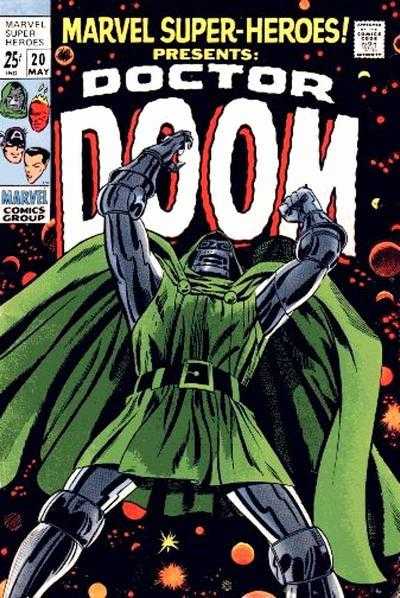 We take a break from our ongoing story for something very different, but vital to Doom's development, in Marvel Super-Heroes #20.
We take a break from our ongoing story for something very different, but vital to Doom's development, in Marvel Super-Heroes #20.
The title "Marvel Super-Heroes" first appeared as the name of a terrible cartoon series in 1966 (which I have moaned about previously) with an accommpanying one-off "Marvel Super-Heroes" comic to go with it. The series which this issue is part of, however, was originally called "Fantasy Masterpieces" and was dedicated to reprints of Golden Age stories. It continued to feature these when the name was changed to "Marvel Super-Heroes" with issue 12, when a "try-out" feature was added as the lead story. The experiment with try-outs had some success, showcasing the first appearances of Marvel's own version of Captain Marvel, The Guardians of The Galaxy and the revived Ka-Zar, although after this issue it would return to all reprints again.
These stories went down well enough for Doom and Ka-Zar to go on to share lead roles in "Astonishing Tales", and you can see why, with Doom at least. This is a really enjoyable character study which adds greater depth to Doom's personality, although it does grate a little when read alongside the story being published simultaneously in "The Fantastic Four". This version of Doom is much more in line with how he's been previously portrayed, as a vain, tortured man who believes he's doing the right thing, rather than the deluded dictator he's transforming into elsewhere.
The story has been very rarely reprinted, appearing as part of "Giant Size Super-Villain Team-Up" a few years later and then in the collected "Essentials" version of the same, but that's about it. It seems odd, as it's a great piece that has lasting repercussions for the way the character would be portrayed.
It all kicks off with Doom reliving some of his past defeats by The Fantastic Four, in an effort to learn what went wrong. I'm all in favour of some personal growth, but right away this differs from the current portrayal of a Doom who doesn't believe he ever is wrong. Here he's quite clear about how many humiliations he's previously faced.
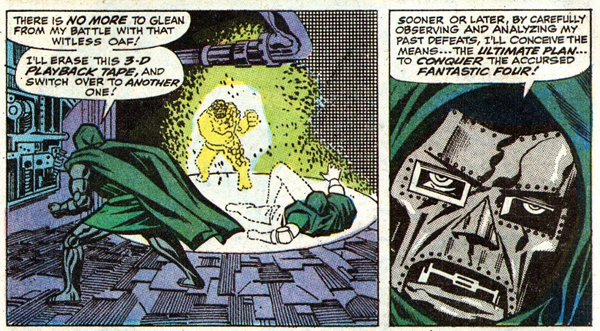 His revision is interrupted when the characters from the "3D Playback Tape" come to life and fight him. Doom does pretty well fighting the illusory Fantastic Four (which at least shows that his studies have been worthwhile) until they fade away, and Diabol reveals himself as being behind the attack.
His revision is interrupted when the characters from the "3D Playback Tape" come to life and fight him. Doom does pretty well fighting the illusory Fantastic Four (which at least shows that his studies have been worthwhile) until they fade away, and Diabol reveals himself as being behind the attack.
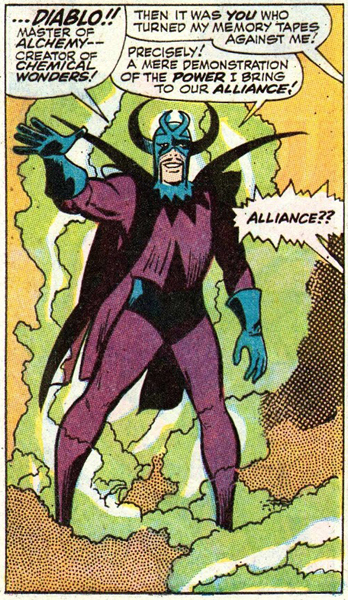 Diablo is there to propose an Alliance, which Doom refuses and, as is the rule for meetings of Supervillains (and most meetings of Superheroes too) they immediately get into a fight. This ends in a stalemate as Doom's science cannot beat Diablo's ... er... Chemistry, so the latter reveals that he has another means of persuading Doom to join him - a hostage!
Diablo is there to propose an Alliance, which Doom refuses and, as is the rule for meetings of Supervillains (and most meetings of Superheroes too) they immediately get into a fight. This ends in a stalemate as Doom's science cannot beat Diablo's ... er... Chemistry, so the latter reveals that he has another means of persuading Doom to join him - a hostage!
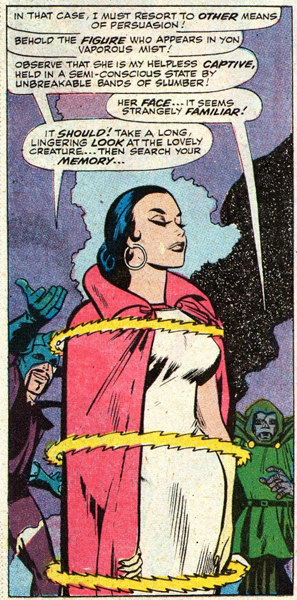 This is a neat turnaround, as it's usually Doom who goes around kidnapping people. The sight leads Doom into a recap of his origin story, this time with another character added, a "childhood friend" who is inserted into a fairly straight retelling of the story, complete with precise reconstructions of a lot of the imagery.
This is a neat turnaround, as it's usually Doom who goes around kidnapping people. The sight leads Doom into a recap of his origin story, this time with another character added, a "childhood friend" who is inserted into a fairly straight retelling of the story, complete with precise reconstructions of a lot of the imagery.
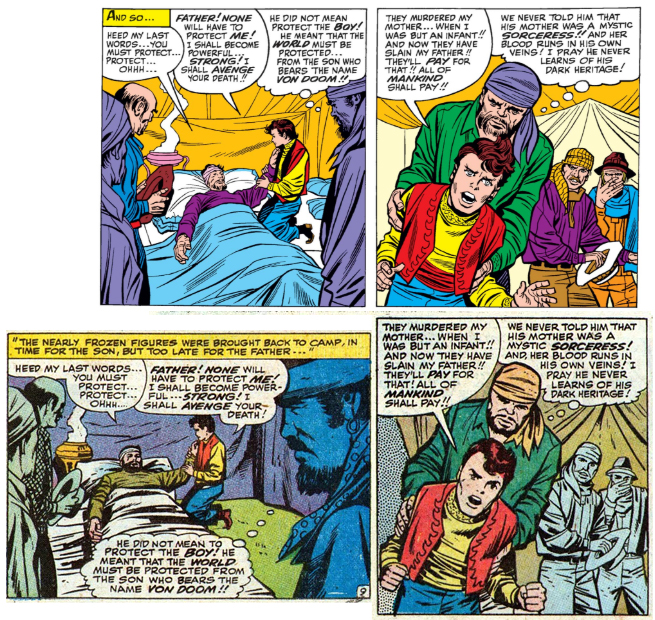 In a very neat bit of retconning the as yet unnamed girl is skilfully slotted in between the frames. The script is co-credited to Larry Lieber and Roy Thomas, with Lieber apparently doing the first half up to page 11, but this does feel a lot like the kind of retelling of history that Roy Thomas would later take much delight in, in series like "The Invaders".
In a very neat bit of retconning the as yet unnamed girl is skilfully slotted in between the frames. The script is co-credited to Larry Lieber and Roy Thomas, with Lieber apparently doing the first half up to page 11, but this does feel a lot like the kind of retelling of history that Roy Thomas would later take much delight in, in series like "The Invaders".
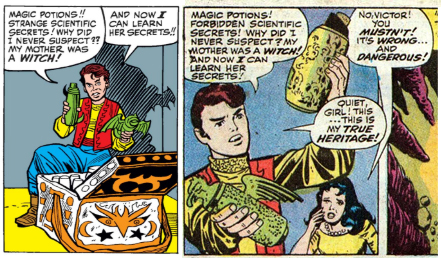 Valeria (as she's finally named on page 10) begs the young Victor to stay in Latveria, but he's determined to to go to America to learn as much as he can about science, as part of his bid for power - the only thing he cares about now. "I have no love... no compassion, not a tender feeling to share with anyone," he tells her, leaving Valeria to mourn the man he once was.
Valeria (as she's finally named on page 10) begs the young Victor to stay in Latveria, but he's determined to to go to America to learn as much as he can about science, as part of his bid for power - the only thing he cares about now. "I have no love... no compassion, not a tender feeling to share with anyone," he tells her, leaving Valeria to mourn the man he once was.
It's all a bit "Ghost Of Christmas Past" really, and once Doom returns to the present day Diablo even tells him that he'll be visited again shortly, though admittedly just by Diablo returning to see if he'll change his mind about teaming up.
The first half of the story then ends with Doom pondering the fact that seeing Valeria has had an unexpected emotional effect upon him.
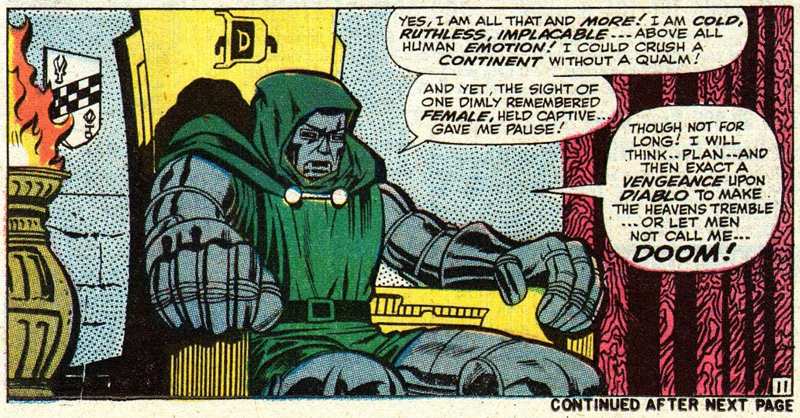 This feels very much like a deliberate end of a "chapter", and the fact that the following page is a splash, recapping what's happened so far, leads me to wander whether this was originally intended to be a two parter? Each part is the same length as Doom's half of "Astonishing Tales" would be, and it make senses of Lieber stopping halfway through and Roy Thomas taking over, so I wonder if this was meant to be the start of that series, but put into "Marvel Super-Heroes" instead? Don't ask me, I don't know!
This feels very much like a deliberate end of a "chapter", and the fact that the following page is a splash, recapping what's happened so far, leads me to wander whether this was originally intended to be a two parter? Each part is the same length as Doom's half of "Astonishing Tales" would be, and it make senses of Lieber stopping halfway through and Roy Thomas taking over, so I wonder if this was meant to be the start of that series, but put into "Marvel Super-Heroes" instead? Don't ask me, I don't know!
The second half begins with more of the self-pity Doom would regularly exhibit during his early years, in a panel which seems to be specifically drawn to recall those stories.
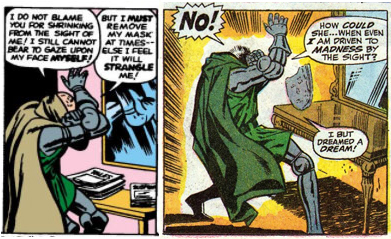 Again, this is very different from the current version of Doom who, only a couple of months ago was not only able to look at himself in a mirror, but was ready to force others to do the same too.
Again, this is very different from the current version of Doom who, only a couple of months ago was not only able to look at himself in a mirror, but was ready to force others to do the same too.
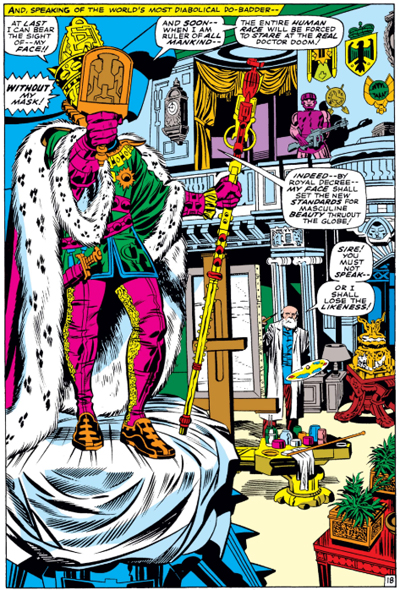 The Grand Comics Database suggests that this story comes before Fantastic Four #84 in continuity, but there's nothing in the text to suggest that it does. Perhaps the Doom currently appearing in The Fantastic Four is just having one of those days where you act like a bit of a dick?
The Grand Comics Database suggests that this story comes before Fantastic Four #84 in continuity, but there's nothing in the text to suggest that it does. Perhaps the Doom currently appearing in The Fantastic Four is just having one of those days where you act like a bit of a dick?
He's definitely in full-on Emo mode here though, eventually consoling himself with the idea that he shouldn't get all upset about his physical appearance when he is who he is - Doom! Positive self-image! You go Victor!
Diablo returns to taunt Doom with images of Valeria, which leads to him taking decisive action and flying off to America, where he finds that - finally - the government has decided that it might be a good idea to maybe put some guards around his old castle/headquarters, rather than letting just anybody wander in as has previously been the case.
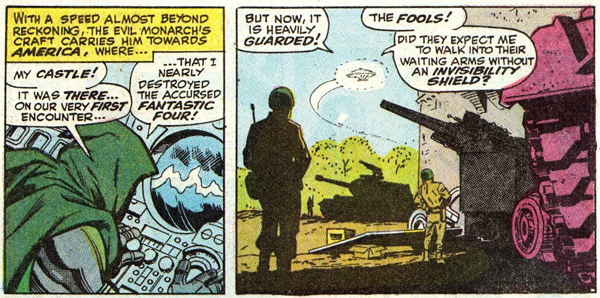 Once past the ineffectual guards he discovers Diablo holding Valeria hostage. How Diablo got in, or how Doom knew he'd be there, are not explained, but then we don't ever find out how Valeira was kidnapped either, or where she's been all this time. Instead Doom decides to destroy the guards surrounding his castle, because he's the kind of guy who likes to take direct action rather than hiding behind politics.
Once past the ineffectual guards he discovers Diablo holding Valeria hostage. How Diablo got in, or how Doom knew he'd be there, are not explained, but then we don't ever find out how Valeira was kidnapped either, or where she's been all this time. Instead Doom decides to destroy the guards surrounding his castle, because he's the kind of guy who likes to take direct action rather than hiding behind politics.
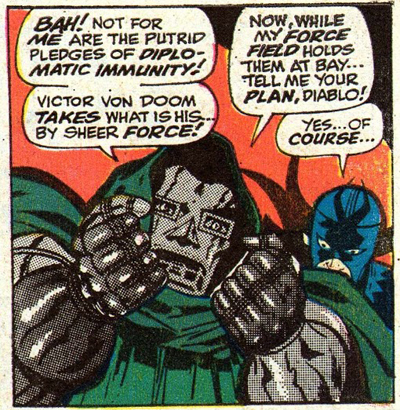 Um... I beg your pardon? Isn't this the same Doctor Doom who has regularly used diplomatic immunity as a key part of his plans and actions? This level of contradiction makes me wonder if Roy Thomas is trying to say something about how the character has changed from his original personality, losing his dynamism to become a statesman instead. It certainly bares little resemblance to the character appearing elsewhere!
Um... I beg your pardon? Isn't this the same Doctor Doom who has regularly used diplomatic immunity as a key part of his plans and actions? This level of contradiction makes me wonder if Roy Thomas is trying to say something about how the character has changed from his original personality, losing his dynamism to become a statesman instead. It certainly bares little resemblance to the character appearing elsewhere!
Diablo has a cunning scheme to use Doom's time machine to alter the course of history, which Doom listens to patiently - after all, others have listened to enough of his mad rants, so it's only polite that he should do the same. He uses his listening time to get close enough to the Time Machine so he can activate a force field, cutting him and Valeria off from Diablo. Another fight ensues, during which Diablo lures Doom onto the Time Machine and then switches it on, only to find that Doom had earlier changed the settings (he did, we saw him do it!) so that it's the person activating the device, not the person stood on its platform, who gets transported. Diablo thus teleports himself into a nightmarish post-nuclear future where everybody else is dead.
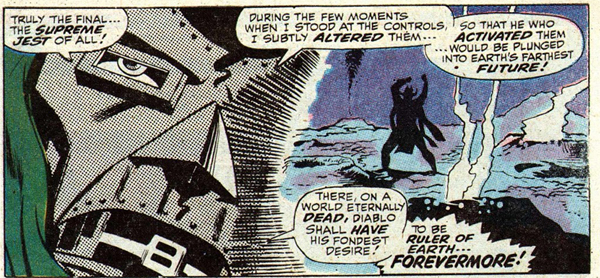 You've got to admit, that's a pretty good trick!
You've got to admit, that's a pretty good trick!
Valeria, however, does not think so. When Doom turns to her, ready to "recapture a lifetime together" she immediately and firmly rejects him.
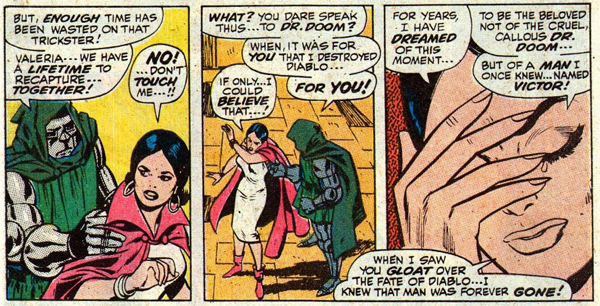 She asks if her appraisal of him is wrong, and he cannot reply, leaving her to walk off.
She asks if her appraisal of him is wrong, and he cannot reply, leaving her to walk off.
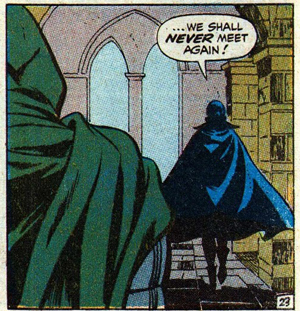
The last page sees Doom alone, in shadow, "knowing, at long last, that it is not his burnt scarred face... his grim metal mask... which are now and forever his merciless prison... but the man himself... the tortured, twisted being whom the world calls only... Doom!!"
Wow! What an ending! What a story! What a great examination of a character which does not entirely line-up with how he was simultaneously portrayed elsewhere!
These two portrayals of Doom will fight it out over the years to come, with one occasionally taking precedence over the other for a period, such as when Doom was all-out evil in Waid & Weiringo's run on "Fantastic Four", only to become tortured and reflective in Brian Bendis's recent "Infamous Iron Man". For now though it's a quick return to the deluded dictator in the conclusion of Lee & Kirby's tribute to "The Prisoner" - next time!
link to information about this issue
posted 22/8/2018 by Mark Hibbett
| < previous | next > |
Comments: